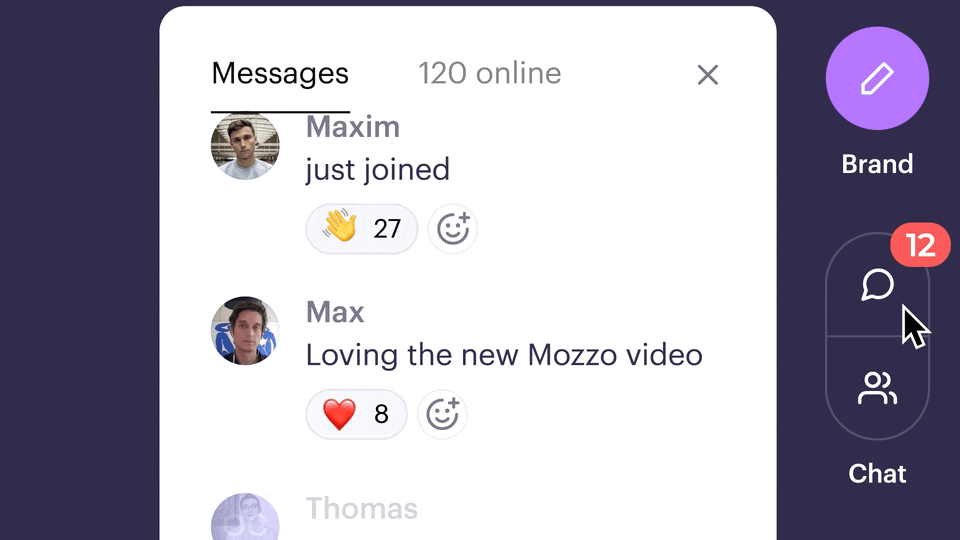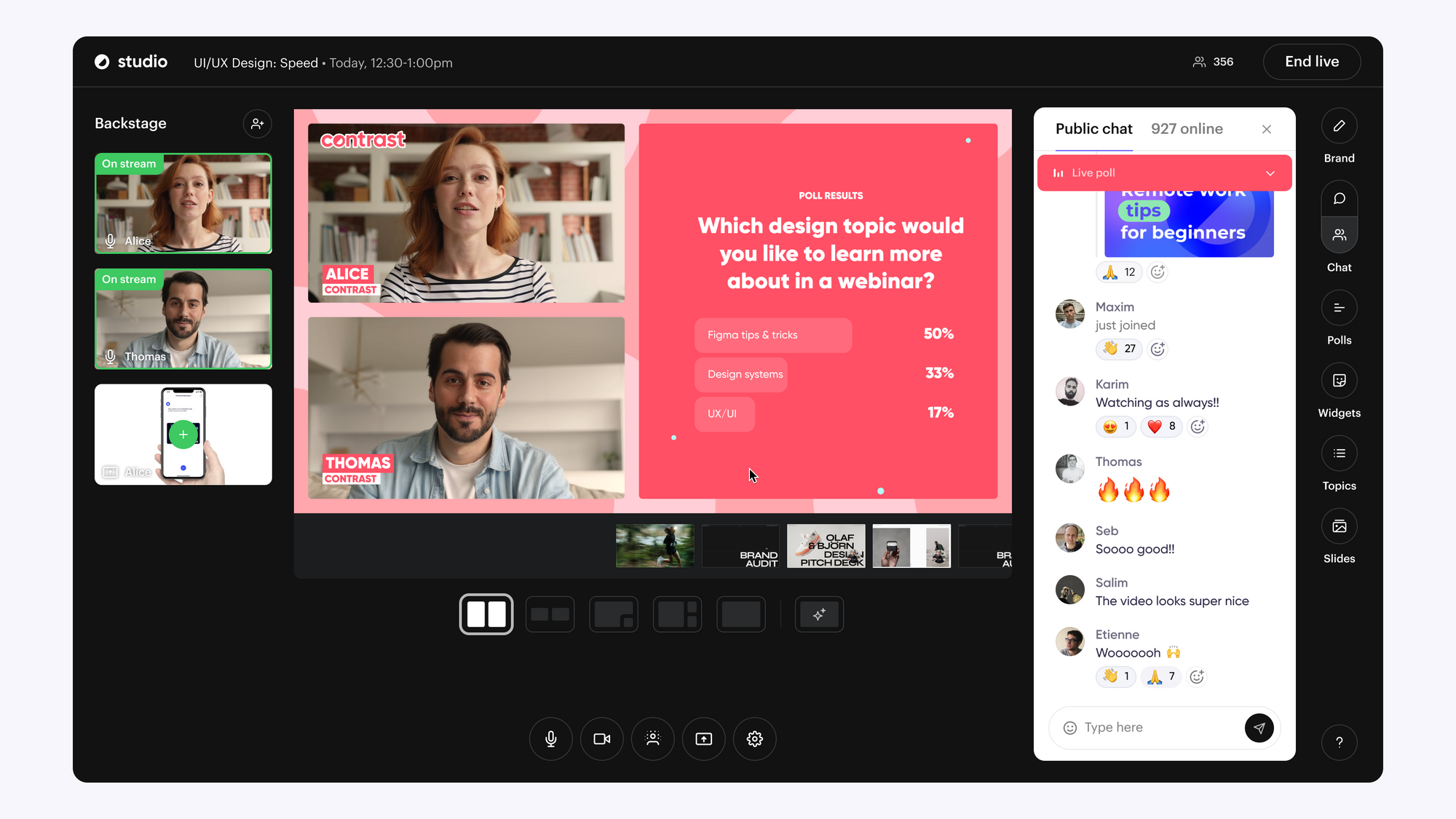Introduction
95% of marketers view hosting webinars as an essential part of their startegy. However, the ability to decipher the true effect of these webinars often remains an elusive challenge.
Even great artists couldn't create their masterpieces without the insights from trial sketches and studies. If you're Michelangelo, your webinars are the Sistine Chapel. The hidden key to perfecting your masterpiece: effective post-webinar survey questions.
Are you harnessing this key to continuously improve your outreach programs? This article dishes out 5 proven post-webinar survey questions, backed by solid research to unveil the valuable attendee feedback.
Time to sculpt your marketing masterpiece!
The 5 Proven Post-Webinar Survey Questions for Effective Feedback
- The first question zeroes in on the overall quality of the session.
- Second and third inquiries help you highlight the strong points and pinpoint areas of improvement.
- The fourth and fifth questions measure how relevant your content was and how likely participants would recommend it to others.
Question 1: How would you rate the overall webinar?
From a bird's-eye view, it’s crucial to understand the overall impression your webinar left on the attendees. Asking for a simple rating on a scale of 1 to 5 or 1 to 10 can provide a quick gauge on the general approval of your webinar. It's about seeing the forest before examining the trees.
Question 2: What did you like most about the webinar?
A deeper dive into specifics, this query grants the opportunity to understand what struck a chord with your audience. It can be the speaker's expertise, the interactive segments, or the relevance of the topic. Knowing your strengths helps you retain that edge for future webinars.
Question 3: What areas do you think could be improved?
Feedback doesn't always taste sweet, but it's necessary for growth. This question supplies you with blunt honesty about your webinar's shortcomings. It can be about technical issues, content depth, duration, or organization. Knowing where you underdelivered delivers a roadmap for betterment.
Question 4: How relevant was the content to your needs?
It's worth asking about the alignment between your webinar content and the attendees' needs. If they cannot relate, it might yield a low recall rate and discourage future attendance. Assessing relevance helps refine content strategy and increases attendee engagement.
Question 5: Would you recommend our webinars to others?
Especially important for expanding your reach, a positive recommendation works like a coded word of mouth. If your attendees express willingness to vouch for your webinars, it certifies your credibility. Tracking this over time can define the success or decline of your webinars, and function as an indirect marketing strategy.
IMPORTANT TO NOTE - Always provide an option for elaborate feedback in case attendees want to share more. This opens doors for in-depth insights and constructive criticism. Leaving a free-form text answer will give you the most honest feedback possible.
The Art of Post-Webinar Survey Design
- Discover the significance of question simplicity and clarity.
- Learn about the balance between open-ended and closed-ended questions.
- Explore when to release the survey and ideal survey length.
Crucial Simplicity and Clarity in Questions
The crucial factor for any survey is simplicity and clarity in its questions. Busy professionals don't have the luxury of time to decode complicated questions. Therefore, ensuring your survey questions are straightforward and easy to understand is paramount.
Writing simple yet clear questions enables respondents to provide accurate feedback. Moreover, it reduces the mental load of your participants, leading to higher response rates and more reliable data.
Start thinking of these questions even before setting up your webinar. They will help guide you through the process.
Balancing Open and Closed-Ended Questions
The use of open and closed-ended questions can significantly influence the kind of feedback you gather. While open-ended questions provide insightful, qualitative data, closed-ended questions bring quantifiable, straight-forward results.
Striking a balance between the two can lead you to grasp the broad sentiments of your audience and allow for precise inferences to be made. Integrating both types of questions in your post-webinar survey can offer you rich, actionable insights about the strengths and areas of improvement of your webinar.
Timing and Survey Length – Getting it Right
The timing and length of your post-webinar survey directly impact the response rate and quality of feedback you receive. It's integral to understand the role & position of the post-webinar survey in the webinar email sequence.
Sending the survey immediately after the webinar, as a follow-up, may help in securing higher response rates as the experience is still fresh in attendees' minds. This recency can lead to detailed, instinctive responses.
As much as timing matters, so does the length. No one wants to spend an excessive amount of time on an overly lengthy survey. Be respectful of your participants' time. Asking a well-crafted, relevant set of questions will help shorten your survey and increase the efficiency of your data collection.
Are your surveys optimal in length and thoughtfully timed? Review your strategy to ensure these elements effectively drive in the feedback you need for continuous improvement.
By delving deep into this art of post-webinar survey design, you'll be on your way to obtaining precise and valuable post-webinar feedback. The simplicity and clarity of your questions, along with the strategic use of open-ended and closed-ended queries, all contribute to this process. Coupled with a well-considered timing and survey length, you are setting the stage for the collection and analysis of imperative feedback.
Analyzing Webinar Feedback for Continuous Improvement
- Know the nuances of attendee feedback.
- Spot emerging patterns from the feedback.
- Make the necessary changes based on the feedback received.
Understanding the Feedback
Webinar feedback is not just about numbers, charts or percentages. It’s about understanding what attendees feel and think about your presentation. Parsing written feedback or understanding emotive sentiments marked in checkboxes require you to listen beyond the words or tick marks.
We're not talking about superficial skim-reading. We mean discerning the tone, emotion, and underlying suggestions that the attendees might not have verbally pointed but hinted at.
It's important however to include survey feedback in your webinar KPIs. As this will allow you to continuously improve your webinar strategy.
Identifying Patterns and Trends
Feedback is not just disparate comments - it’s a storehouse of tendencies and patterns about the attendees’ experience. Comprehending these patterns will allow you to understand what works and what not in your webinar.
Are there common concerns raised by multiple attendees about the content? Do they find the presentation engaging or monotonous? These trends can guide towards insightful data about the good, the bad, and the ugly of your webinar.
Implementing Changes Based on Feedback
Feedback is meaningless if not acted upon. Spotting issues without making improvements- is a lost chance. If attendees feel the content was too advanced, it implies that your webinar should target a more niched, expert crowd.
A pattern of appreciative comments about the Q&A, suggests that this a strength to build upon. Maybe allot more time for Q&A in future webinars. Driving changes based on distinct patterns will lead to future webinars that hit right on target.

Alleo, a Contrast client, uses pre and post-webinar surveys to understand how relevant the content is right now to their audience. This helps them decide on the future topics for their webinars.
Other clients use polls to ask their audience questions about the webinar in real-time, giving them a ton of feedback on what they like, dislike, and what could be improved upon.
There it is, a stepwise approach to improve your webinars, capitalizing on the attendees' feedback. Not merely a habit but a continuous process, feedback analysis has the potential to transform good webinars into great. The goal is deciphering feedback, spotting patterns, and driving change. The journey - from extracting meaning from feedback, to implementing learnings - ensures webinars that are polished, appreciated by attendees, and generate ROI.
Webinar feedback, if used right, isn't just a mirror showing your presentation's reflection. It’s a compass, directing your future webinars towards success. No summary needed here, its simplicity lies in its approach and the multi-fold benefits it offers. Time now to act on it.
Making your webinars fun is also a great way to improve the feedback loop!
The Impact of Effective Webinar Feedback on Future Webinars
- Unveils how to refine the quality of webinar content.
- Discloses the importance of modifying presentation style.
- Explores the benefits of optimizing webinar logistics.
Enhancing Content Quality
High-quality content is the backbone of planning a successful webinar. Feedback provides first-hand information about what worked and what didn't from your audience's perspective.
In determining content quality, it's crucial to look at two denominators: relevance and value. If your webinar content is relevant to your audience and offers value, it's a win-win situation.
By employing feedback from post-webinar surveys, you can determine the hot spots that grasped the audience's attention and the areas that fell flat. Combine this with data regarding watch time and other webinar analytics. This knowledge allows you to focus on producing content that makes an impact and steers clear of areas that diluted the value.

Learning what educational content needs amplifying and comprehension is key to an impactful webinar. You can spot gaps in your content strategy and fill them based on insightful responses from your audience.
Improving Presentation Style
The style of presentation holds equal weight to the content quality in a webinar. An engaging presenter keeps the audience hooked; an uninteresting one might draw yawns and early exits.
The best webinar tools will also provide features to help engage your audience like Q&A, polls, on-screen transitions, and more.

Run the Most Engaging Webinars
Start for free with up to 30 registrants. No credit card needed.
Start for freeWith feedback from post-webinar surveys, you can learn if your presenter connected with the audience, told a compelling story, and communicated effectively. You can decode if it was a valuable interaction or a one-sided monologue.
Analysis of this feedback offers deeper insights into aspects of the presenter's style - tone, pace, eloquence, and responsiveness. Adopting real-time changes based on this feedback can result in a webinar experience that leaves a lasting impression.
Optimizing Webinar Logistics
From the timing of your webinars to the platform used to the number of participants accommodated - every logistical detail impacts the attendee experience. Feedback data offers practical, actionable insights into better scheduling and fine-tuning the technical aspects of your future webinars.
Audience feedback can suggest if the day and time of the webinar worked for them or not. If your webinar suffered multiple interruptions due to a faulty software, you might want to switch to a more reliable one.
You can also plan better by understanding if the duration of your webinar was just right or if it slightly overstretched. Perhaps your audience prefers a concise 30-minute interactive webinar over a dreaded 90-minute one-sided presentation.
In a nutshell, post-webinar surveys have immense potential to optimize the logistics of future webinars and drive participation rates up.
By focusing on these three pillars - content quality, presentation style, and logistics, you are unlocking the door to streamlined, superior, and successful future webinars. Your audience will thank you for a worthwhile experience and will be more likely to return for more.
Case Study: Improving Webinar Experience through Post-Webinar Surveys
- Insightful overview of a company's challenge and response
- Application of post-webinar surveys for actionable feedback
- Evidence of significant improvements made
Company Profile and Challenge
Every successful webinar experience begins with a share of trials and challenges behind the scenes. Take for instance, Elevo, a software provider in the human resources industry. The company has an extensive clientele built largely through informative webinars, marketing actions, and gated content. BUT, there was a hitch: Elevo was struggling to get as many people to sign up and show up to their webinars as they wanted. Unclear about their target audience's concerns or demands, they watched frustratingly as webinar attendances never took off.
Implementation of Post-Webinar Surveys
Determined to increase their audience engagement, Elevo incorporated two essential tools – live polls and post-webinar surveys. The strategy was simple and based on the wisdom of Customer Feedback Loop: ask the audience what they want to hear, what works, and what doesn't. So, with each webinar they ran, they used post-webinar survey questions to get data that would help gauge the effectiveness of their event, identify strengths, and reveal areas needing improvements.

A Closer Look at the Survey Questions
The questions, which were designed to be straightforward and quick to answer, focused on gauging the participants’ learning, their overall experience, the relevance to their roles, the effectiveness of the presenter, and the likelihood of recommending the webinar to other industry professionals.
Results and Improvements Made
The feedback from these post-webinar surveys was a game-changer. Elevo not only established what their webinar participants enjoyed, but they could also identify where they were falling short. With the latter, they could introduce precise modifications based on real-time audience feedback.
The feedback led to changes in their presenter lineup and scheduling. The surveys also helped them uncover new topics that genuinely interested their target audience. They were then able to engage their audience and generate leads much more easily using Contrast as their webinar tool.
In the end, the proof was in the pudding. Within just a few webinars, Elevo experienced a consistent rise in engagement rates, leading to higher attendance and more active participation. Post-webinar surveys helped the company do better at what they do best: educating their customers and providing efficient networking solutions.
Efficient feedback collection and analysis led Elevo to understand their target audience better, improve their webinars, and in turn, see a visible return on their efforts.

Maximize the Impact: Elevate Your Webinar Feedback Game
The power of survey questions post-webinar cannot be understated - increasing relevancy, refining your content, and enhancing audience engagement. You've discovered the proven value of five essential webinar survey questions and the science behind them. Respondents reveal insights beyond mere satisfaction - divulging learning experience, content quality, and participation likelihood.
This knowledge not only boosts your webinar returns but is pivotal in improving your future webinar strategies. Is it time now to revisit your post-webinar survey game plan?
All set? Time for action. Take the insights presented and craft those well-structured, clear, and targeted post-webinar survey questions. Efficient feedback collection starts with effective question choice - you've got that now. Remember, every response is a step towards understanding your audience better and delivering impactful webinars.
And don't forget to check out the new way to run webinars by signing up for a free account on Contrast.
So, how will you use these powerful survey questions to transform your post-webinar feedback strategy?
Forge ahead, and let your post-webinar surveys do the talking. People speak, and the data shouts back. Future webinars are waiting to bask in the glow of your newfound wisdom.

The Most Engaging Webinar Experience
Start for free with up to 30 registrants. No credit card needed.
Start for free